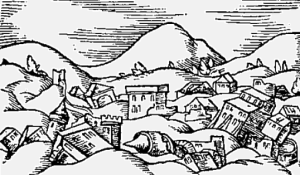

 |
 |
Earthquakes were well known in the ancient Greece but the physical understanding of such phenomenon was lacking since scientific knowledge and thinking were non-existent at those times. In modern times when geologists began regulary to inspect sites of damaging earthquakes they were struck by large surface ruptures showing that abrupt topographic changes had taken places. It then became clear that earthquakes in general are intimately connected with deformations of the Earth surface that create mountains, rift valleys, mid-oceanic and so forth. Geologists speculated that quick large-scale shifts of the surface rocks were the ultimate cause of intense ground shaking generally termed earthquakes. |
 |
Nowadays, shallow earthquakes are reagarded as almost all having the same albeit seldom tied to free surface ruptures. These ground tremors stem from deformations in the Earth's interior - down to 700 km in the extrem - resulting from socalled tectonic forces. Seismology is as mentioned also tied to propagating seismic waves and their initation is the sudden slip along a geological fault equivalent to a discontinuity surface.
The following animation shows how an earthquake occurs: tectonic forces deform the rocks at the Earth surface until they break. Mouse click on image to start or reset.